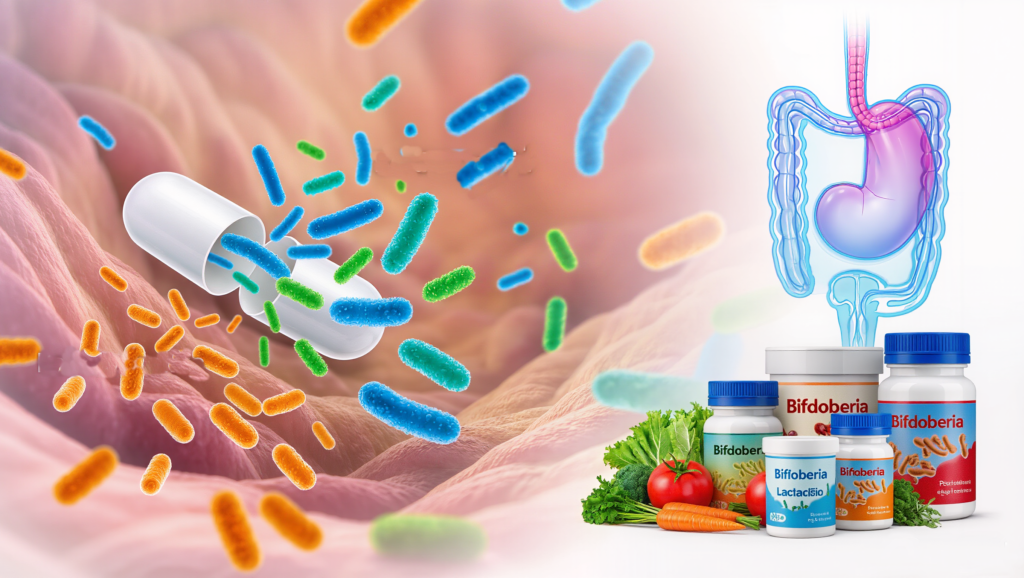Probiotics are everywhere—from supermarket yogurts to daily supplements, promising everything from a happy gut to clearer skin and a better mood. But not all probiotics are created equal. If you’re chasing real results, there’s a strong scientific case for zeroing in on two superstar families: Bifidobacteria and Lactobacillus. Here’s what makes these bacteria so important, how they work, and how to make sure you’re getting the right strains for optimal gut and total body health.
What Are Probiotics and Why Do They Matter?
Simply put, probiotics are live microorganisms (bacteria or yeast) that, when consumed in adequate amounts, provide health benefits by enhancing your body’s natural microbial ecosystem. A healthy human gut contains trillions of microorganisms—and a diverse, robust microbiome is linked to everything from better digestion and immunity to mood regulation.
Why Bifidobacteria and Lactobacillus Are the MVPs of Probiotics
Meet The Two Major Players
- Bifidobacteria: These are among the first microbes to colonize the infant gut (especially if you were breastfed) and remain critical throughout life.
- Lactobacillus: Ubiquitous in the gut, mouth, and urogenital tract, these bacteria are involved in food fermentation, breakdown of plant fibers, nutrient synthesis, and keeping other microbes in check.
Together, bifidobacteria and lactobacilli dominate most quality probiotic formulations and make up the backbone of most research-backed functional and fermented foods.
Health Benefits: What the Science Shows
Digestive Health & Symptom Relief
- Lactobacillus species can help maintain and restore gut balance, protecting against harmful bacteria, preventing diarrhea (including antibiotic- and infection-induced), and alleviating symptoms of IBS and lactose intolerance.
- Bifidobacteria are essential for producing short-chain fatty acids (acetate, butyrate), which nourish colon cells, calm inflammation, feed good bacteria, and lower colon cancer risk.
- Research shows Bifidobacterium is particularly effective at reducing gas, bloating, and abdominal pain—even outpacing some Lactobacillus strains for these symptoms.
Immune and Allergic Modulation
- Both genera modulate the gut-immune axis, promoting stronger IgA production (frontline immune defense) and regulating anti-inflammatory T-cell responses.
- Supplementing with Bifidobacterium and Lactobacillus can enhance the gut barrier, making it harder for pathogens to invade and cause illness.
Mood & Mind Influence
- The gut-brain axis is real: Clinical research links both Bifidobacterium and Lactobacillus to lower rates of depression and anxiety, for children and adults alike.
- Strains such as Lactobacillus rhamnosus and Bifidobacterium longum are known for supporting emotional well-being and lowering stress-related behaviors.
Additional Perks
- Both help maintain vaginal and urinary tract health (especially for women) by crowding out pathogenic fungi and bacteria.
- They assist in nutrient absorption (especially B vitamins and vitamin K) and may even decrease cholesterol, enhance skin health, and promote metabolic wellness.
Not All Probiotics Are the Same: Strain Matters!
Each species (and even individual strains) of Bifidobacterium or Lactobacillus offers unique benefits. For example:
| Species | Notable Strains | Key Benefits |
|---|---|---|
| Bifidobacterium animalis | BB-12, Bi-07, HN019 | Gut regularity, immune health, bloating relief |
| Bifidobacterium longum | ssp. longum 35624 | IBS, mental wellness |
| Lactobacillus acidophilus | NCFM, LA-5 | Most studied, supports digestion, immunity, breaks down lactose |
| Lactobacillus rhamnosus | GG | Reduces diarrhea, helps with allergies, strengthens barrier |
| Lactobacillus plantarum | 299v | Eases IBS, boosts resilience |
| Bifidobacterium breve | Yakult, K-110 | May support colic, eczema in infants |
Strain-specificity is why some probiotics work great for one person but not another—or for certain conditions but not others. Always check for strain designations (e.g., L. acidophilus NCFM) on labels over vague “proprietary blends.”
Are Supplements or Foods Better?
- Supplements: Offer higher, more targeted doses of proven strains. Go for brands with clear strain and CFU numbers, 3rd-party testing, and a guarantee of live bacteria through expiration.
- Fermented Foods: Kefir, yogurt (with live cultures), sauerkraut, kimchi, and miso are excellent sources—though cultures are diverse and counts lower than clinical doses.
- Synbiotics: Combining probiotics with prebiotics (fibers that feed good bacteria) amplifies benefits.
A combination of both food and supplement creates a broader microbial “ecology” for greater gut stability.
Getting the Right Probiotic for Your Needs
Think Beyond the Hype
Some products pack 10+ strains and 50+ billion CFUs, but more isn’t always better. Match your goals to the science:
- For gas and IBS: Seek Bifidobacterium (esp. BB-12, HN019, 35624).
- For antibiotic recovery/diarrhea: Lactobacillus rhamnosus GG is especially potent
- For overall digestion/immune support: Multi-strain blends with researched strains offer broad coverage.
- For mood/stress support: Look for B. longum 1714, L. rhamnosus GG, L. plantarum 299v.
Ask your provider about recommendation—especially if you’re immunocompromised, as some people need to avoid probiotics due to infection risk.
The Dynamic Duo: How Bifidobacteria & Lactobacillus Work Together
- Synergy: Studies show introducing Bifidobacterium can even help increase levels of beneficial Lactobacillus, crafting a gut ecosystem that’s more resilient to inflammation and infection.
- Relay: This relationship is particularly powerful for gut healing, as Bifidobacteria often act as “pioneer” species, prepping the terrain for Lactobacillus to colonize and thrive.
The two complement each other—Bifidobacteria produce key fatty acids (like acetate) that benefit colon health, while Lactobacilli bolster the immune barrier and prevent pathogen colonization.
Key Shopping Tips
- Check labels for strain type and CFUs (colony forming units) at expiration—not manufacture.
- Look for 3rd-party testing (NSF, ConsumerLab) and refrigeration if required.
- Avoid generic blends with no strain identification or exaggerated marketing claims.
- Rotate or tailor strains for changing life stage, diet, travel, or health shifts.
- Don’t rely solely on supplements—diversify with fermented and fiber-rich whole foods.
Final Thoughts: Precision Counts with Probiotics
Focusing on evidence-backed Bifidobacteria and Lactobacillus strains sets the gold standard for probiotic effectiveness in digestive, immune, and mental health. It’s not about “more is better,” but “right is better”—the right strains, at the right doses, for your specific gut and goals. Stay curious, read labels, check the research, and support your microbiome with both targeted probiotics and a fiber-rich, colorful, fermented-food-friendly diet.








